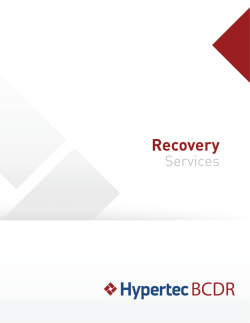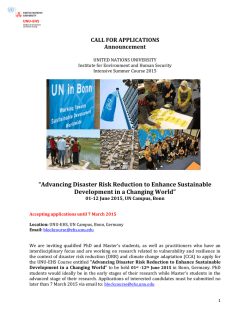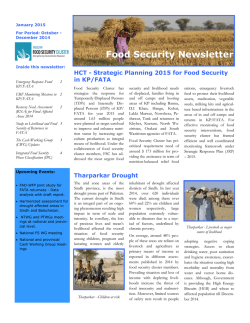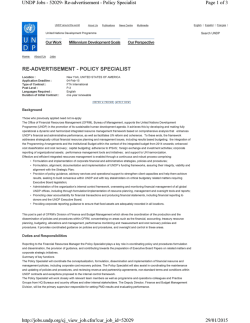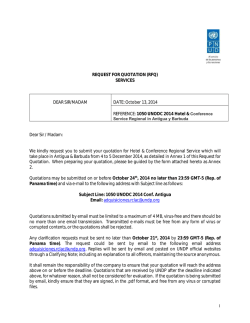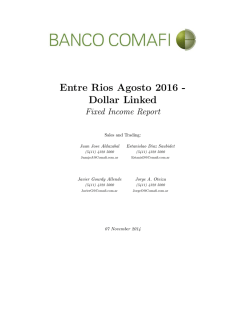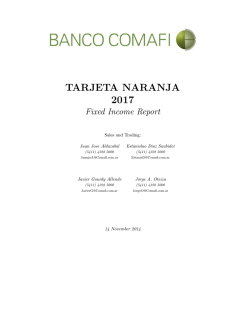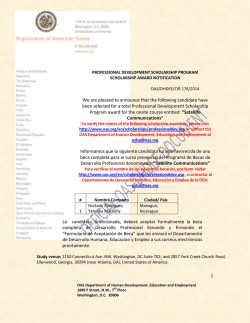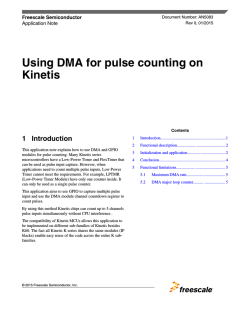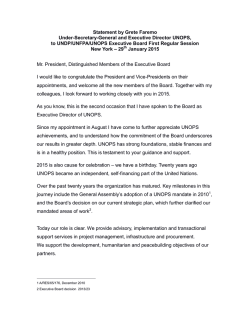
PROJECT FACTS – SWAZILAND
Disaster Risk Reduction and Recovery PROJECT FACTS – SWAZILAND Strengthening National and Local Resilience to Disaster Risks in Swaziland Total Budget: USD 559,000.00 UNDP/BCPR: UNDP (Regular): Government: USD 380,000.00 USD 48,000.00 USD 131,000.00 Project ID: 00061867 Period: August 2008 – July 2010 Partners: Disaster Management Agency (DMA), National Meteorological Service. Background Swaziland is experiencing a new humanitarian crisis resulting from: the HIV/AIDS pandemic; deepening food insecurity due to erratic rainfall extremes; poverty; and the declining capacity of national institutions to effectively provide adequate social services. Consequently, the disaster resilience and coping mechanisms of households continue to be negatively affected. In 2005, the Government of Swaziland, together with UNDP, conducted a National Disaster Risk Reduction (DRR) Capacity Needs Assessment. It identified resource constraints and capacity gaps in the following areas: a) institutional and legal systems for DRR; b) risk identification; c) information and knowledge management; d) emergency response and preparedness; and e) risk management. Project Summary Key Objective To strengthen national and local resilience to disaster risks within the context of sustainable development. Expected Results Legal and institutional framework for disaster risk reduction (DRR) reviewed and developed. Risk identification mechanisms improved. Information and knowledge management for DRR enhanced. The project strategy is focused on strengthening national and Disaster preparedness and emergency response local resilience to disaster risks, as well as managing/reducing practices strengthened. disaster risks effectively, thereby contributing to poverty reduction and sustainable development in Swaziland. The Gender equality strengthened project supports the development of capacities in the following in DRR implementation. areas: a) legal and institutional systems for DRR and climate adaptation; b) disaster risk identification, and early warning linked to climate change adaptation programmes; c) integrating risk reduction into development initiatives; and d) preparedness and emergence response at local level. Activities Develop capacity of the DMA, other government departments, the UNDP Country Office and other stakeholders in DRR; Review the disaster management policy, revise as necessary and implement; Review and develop a drought risk management policy, and a national action plan for capacity development in DRR; Establish and operationalize disaster management institutions at national, regional and local levels; Conduct training on DRR as well as on roles and responsibilities of disaster management institutions at regional and local levels and climate risk management/DRR advocacy/ training for legislators, Governors, Permanent Secretaries and DMA Board on DRR; Mainstream DRR into the national development plan, the Poverty Reduction Strategy and UNDP country programmes/projects; Conduct training in climate/disaster risk assessment/analysis with special focus on drought/floods, for DMA, other key government departments, sectors, UN agencies, private sector and institutions of higher learning; Establish a National Disaster Risk Assessment Team and institutionalize the Team; Undertake risk assessment in two regions (Lubombo and Shiselweni) and at least one community in each of these regions and produce hazard and risk maps; Present results of the risk assessment/analysis to all stakeholders and discuss relevancy and use for development planning; Facilitate design and compilation of development plans including the Poverty Reduction Strategy and UN Programmes using risk assessment/analysis results; Review and establish effective early warning systems at national, regional and community levels; Design, fund and implement a community risk management project as a pilot project on use of risk assessment in development programming; Conduct public awareness campaigns as well as training on DRR through chiefdoms; Undertake consultative meetings with educationalists on mainstreaming DRM (especially drought risk management) into the schools curricula,develop materials and pilot them in at least one school; Conduct advocacy meetings/training on disaster risk management for the media and review and update the Swazi disaster risk management website; Establish an information management system for DRR – including data on disaster losses, risk maps, hazard maps, DRR plans and activities; Conduct training on emergency response and preparedness including rapid and early recovery needs assessment for major hazards; Develop guidelines and tools for rapid, immediate, and recovery needs assessments and train key stakeholders on their application; and conduct training on early recovery planning; Prepare/develop and periodically update disaster preparedness and contingency plans at all levels with particular focus on the most vulnerable areas and groups; Integrate DRR into emergency management and response strategies at national, regional and community levels; Conduct a gender-focused analysis of drought/disaster impact and document results, and incorporate a gender analysis in risk assessments, policy and legislative development; Strengthen women’s DRR networks and activities; and organize at least one regional workshop on gender and disasters in Swaziland; and compile lessons learnt report on women and DRR in Swaziland. Achievements to date Legal and institutional framework for DRR Review of the national disaster management policy initiated (ongoing). National Action Plan for DRR covering the period 2008-2015 developed and approved by the Cabinet (currently being implemented). DRR focal points established, though not yet fully operational. Support provided towards the institutionalization of the Swaziland Vulnerability Assessment Committee (SVAC). SVAC now integrated into the new DMA structure. Information and knowledge management for DRR DRR Information, Education and Communication (IEC) materials developed in collaboration with education stakeholders. Development of these materials included training/transfer of knowledge on DRR concepts. IEC materials currently awaiting piloting before they can be rolled out into the schools’ curricula. Media advocacy for DRR successfully conducted as evidenced by coverage of advocacy meeting conducted with media personnel. Disaster preparedness, emergency response and early recovery Training on emergency response and preparedness conducted, including rapid and early recovery needs assessment for drought hazards. Drought early recovery needs assessment conducted and report published. Furthermore, drought early recovery strategic framework developed. National contingency plans developed. Inter-Agency Contingency Plans on cholera, bushfires and El Nino implemented. Gender equality in DRR implementation Gender-focused situational analysis study of socio-economic impacts of disasters underway. Capacity development/trainings Capacity of National Disaster Management Agency (NDMA), other government departments, UNDP Country Office and key stakeholders developed in the following DRR areas: a) understanding DRR concept; b) early recovery including development of drought early recovery strategic plan; c) application of DRR tools for mainstreaming in development programmes, plans and policies; and d) contingency planning. Training conducted in application of DRR tools for mainstreaming in development plans, programmes and projects. Pilot projects on DRR A community disaster risk management pilot project implemented in collaboration with World Vision Swaziland. Main objective is to establish a DRR system at community level. Contact information: UNDP Country Office Swaziland Website: http://www.undp.org.sz/ For further information: Hyogo Framework for Action (HFA) Progress Monitor Website: http://www.preventionweb.net/english/hyogo/progress/reports/?pid:222&pil:1 last updated: April 2010
© Copyright 2026
